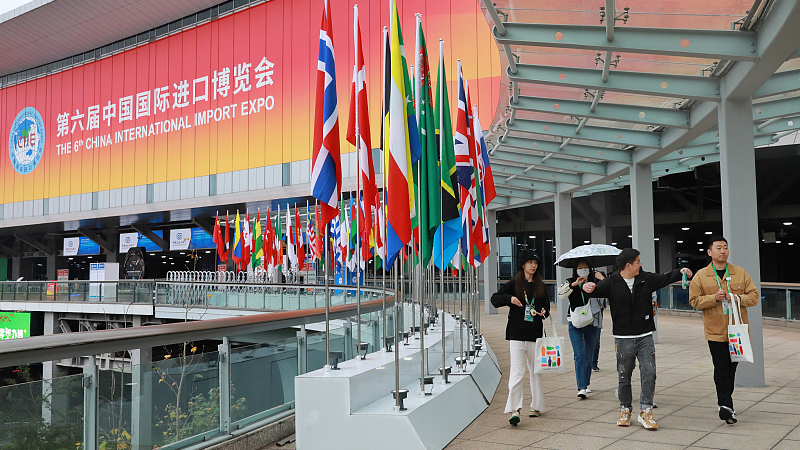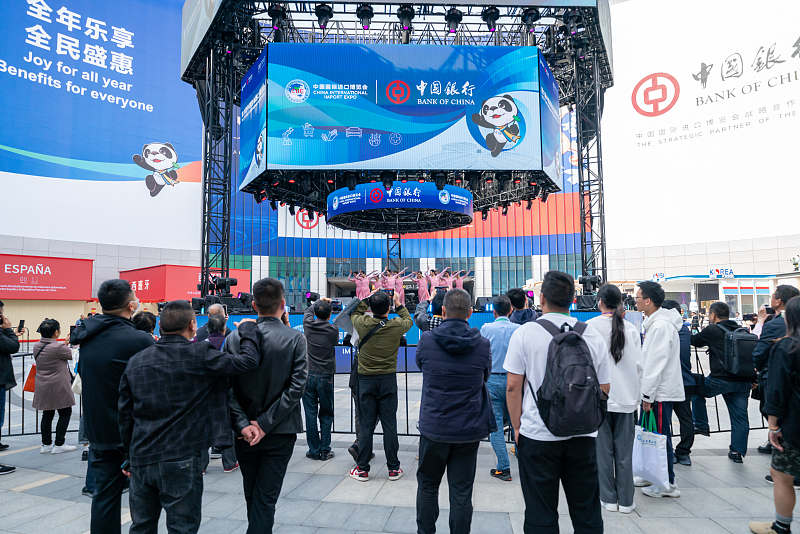
The sixth China International Import Expo (CIIE) concludes with success in east China's Shanghai, November 10, 2023. /CFP
The sixth China International Import Expo (CIIE) concludes with success in east China's Shanghai, November 10, 2023. /CFP
Editor's note: Andy Mok, a special commentator on current affairs for CGTN, is a research fellow at the Center for China and Globalization. The article reflects the author's opinions and not necessarily the views of CGTN.
In the high-stakes and big-dollar game of global semiconductor competition, the China International Import Expo (CIIE) has become the arena where the world's leading chip companies contend with a significant geopolitical conundrum. These firms are drawn inexorably to the opportunities within China's burgeoning market, the vitality of which is underscored by the International Monetary Fund's recent upgrade of China's economic growth forecast. The allure of China's market, set against the stage of the CIIE, is not merely a commercial attraction – it's an economic imperative.
At the CIIE, the "Integrated Circuit Special Section" was a busy hub where 47 companies involved in chips were displaying their latest products. Major players from countries including the United States, Japan, the Netherlands, and South Korea – names like Qualcomm, Micron Technology, ASML Holding, and Samsung Electronics – were all present. Their participation went beyond just showing up. It showed their strong commitment to China's growing market. Despite facing a sales ban, Micron attended for the first time, drawing attention from high-profile visitors such as China's Commerce Minister Wang Wentao and U.S. Ambassador Nicholas Burns. The size and design of their booths were not just for show. They represented the companies' serious plans and investments in China's tech sector.
Corporate executives and experts at the expo have not been reticent about their ambitions. Senior Vice President of Dutch semiconductor equipment company ASML, Shen Bo, conveyed a robust confidence in the market, stating that despite regulatory hurdles, "we are highly optimistic about the Chinese market's performance next year." This optimism is buoyed by substantial revenue contributions from the Chinese market, which accounted for 46 percent of ASML's total revenue in the third quarter, up from 24 percent in the second quarter.
This chorus of corporate optimism, as echoed across the sprawling booths at CIIE, underlines a broader industry consensus: regardless of the drumbeat of decoupling, the semiconductor sector's future is inexorably tied to global cooperation, with China as a central axis of this interconnected machinery.
However, this gravitational pull towards China is fraught with political tension. A growing narrative from various governments calls for a decoupling from China's technological ecosystems, citing national security and economic self-sufficiency. This narrative is at odds with the semiconductor industry's integrated and interdependent nature, where innovation and market access are global.

The central square performance of the sixth China International Import Expo (CIIE) in east China's Shanghai, November 6, 2023. /CFP
The central square performance of the sixth China International Import Expo (CIIE) in east China's Shanghai, November 6, 2023. /CFP
The IMF's bullish outlook on China, revising its economic growth forecast to 5.4 percent for 2023 from the previously projected 5 percent, only adds fuel to the geopolitical fire. This upgraded forecast isn't merely an acknowledgment of China's robust post-pandemic resurgence; it's a potent indicator of the market's substantial long-term growth potential, now predicted to continue with a 4.6 percent increase in 2024.
For the global semiconductor industry, this projection elevates the urgency to secure and possibly broaden its presence in China – a market crucial for its international expansion and profitability. This economic signal, underscored by China's recent fiscal stimulus of an additional 1 trillion Chinese yuan (about $137.3 billion) in treasury bonds, is too significant for global players to disregard, as it holds profound implications for their strategic planning and market performance.
The stakes are clear: Access to the world's largest semiconductor market can dictate a company's future in the industry. Yet, as these companies align their sails to catch the winds of China's economic propulsion, they also navigate the crosscurrents of their home countries' geopolitical strategies. The push for decoupling is not only a challenge to individual companies but also a potential impediment to the sector's global progress. As semiconductor technology becomes ever more critical to national economies and security, the tension between market imperatives and political directives has never been sharper.
What unfolds at the CIIE is thus more than a trade show – it is a microcosm of the global chip race, reflecting both the immense potential of cooperation and the risks of fragmentation. In this context, the IMF's upgrade serves as a reminder that economic currents often flow stronger than political ones. For global chip companies, the imperative is clear: they must advocate for a nuanced approach that balances the geopolitical concerns of their governments with the economic realities of a globalized industry. The CIIE's showcase of its commitment to the Chinese market is a testament to this delicate balance – a balance that will shape the future of the global semiconductor industry and, by extension, the technological landscape of the 21st century.
As the CIIE concludes, the dialogue initiated and the relationships deepened within its framework have set the stage for a ripple effect throughout the global semiconductor landscape. Industry leaders, by emphasizing the importance of the China market as well as cross-border collaborations and emphasizing innovation at this nexus of international trade, are not only sending a powerful signal but also collectively steering the industry towards a horizon of expansive technological growth. The partnerships nurtured here can catalyze advancements in chip design and manufacturing, propelling the industry into a future where the synthesis of market dynamics and technological innovation drives a new chapter of global digital transformation.
(If you want to contribute and have specific expertise, please contact us at opinions@cgtn.com. Follow @thouse_opinions on Twitter to discover the latest commentaries in the CGTN Opinion Section.)



